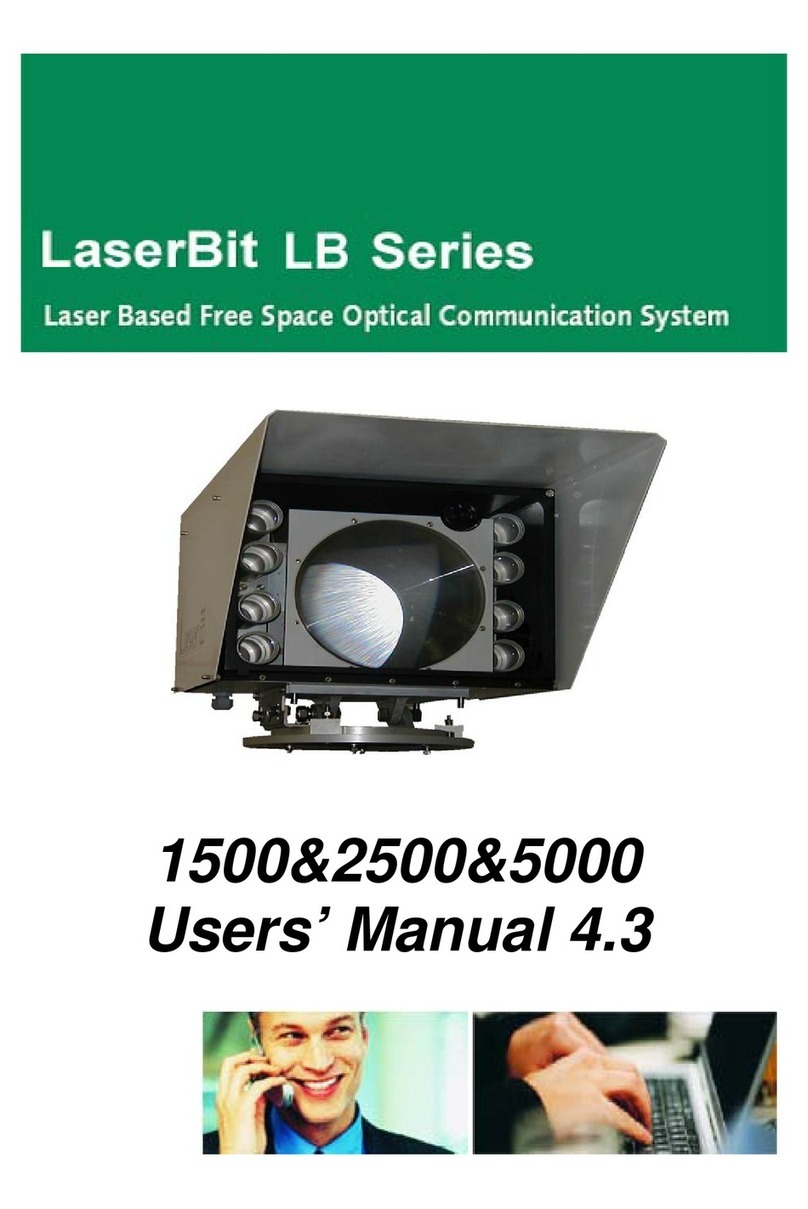
LaserBit Giga Series 4.3 page
3
Elektrische Sicherheit des Laserbit Produkts
Das Laserbit ist eine Klasse 3B Lasereinrichtung.
Das Laserbit Produkt wurde geprüft und entspricht den Anforderungen der
Europäischen Standards EN 60825-1:1994+A11:96+A2:2001 (Lasereinrichtungen),
EN 60950-1:2001 (Elektrische Sicherheit),
EN 55022:1998+A1:200+A2:2003 Klasse 3B (EMV, Störaussendung) und
EN 55024:1998+A1:2001+A2:2003 sowie EN 61000-6-2:2001 (EMV, Störfestigkeit)
Der Laserstrahl wird von der Sendeoptik durch die Glasscheibe an der Frontseite
des Laserkopf mit einer Divergenz von weniger als 10mrad abgestahlt. Es sind keine
weiteren Blenden vorhanden durch die Laserstrahlen auftreten können.
Warnung!
Unsichtbare Laserstrahlen! Nicht direkt in den Lasertrahl schauen,
da dies die Augen permanent schädigen kann. Der
Sicherheitsabstand variiert mit der Laserleistung und Divergenz
des Laserstrahl. Details hierzu sind im Datenblatt nachzulesen.
Das Laserbit Produkt muß so installiert werden, daß niemand Zutritt zu der Optik
des Laserkopf hat oder zufällig in den Bereich des Laserstrahl kommen kann.
Kapitel 5.3.5 auf Seite 20 des Handbuchs enthält ausführliche Anweisungen zum
Schutz der Augen.
Das Laserbit Produkt ist mit allen notwendigen Warnhinweisen versehen die durch
die Standards vorgebenen werden. Weitergehende Hinweise sollten an gut
sichtbaren Stellen angebracht werden wo man sich dem Laserkopf gefahrlos nähern
kann. Die Positionen der Warnhinweise sind auf Seite 20 des Handbuchs dargestellt
(Kapitel 5.3.5, Schutz der Augen)
Die „Outdoor Interconnection Unit“, die mit einem zertifzierten Netzkabel ausgeliefert
wird, muß mit der Stromversorgung verbunden werden, indem der Netzstecker in
eine geeignete Netzsteckdose gesteckt wird, womit die Lasereinrichtung auch
jederzeit wieder vom Netz getrennt werden kann. Jegliche Modifikationen an der
Installation sind verboten.
Falls aufgrund nationaler Vorschriften denoch Änderungen an der Installation
vorgenommen werden müssen, ist vorher der Hersteller zu befragen.
Um die Konformität bezüglich der Elektrischen Sicherheit nach EN60950
sicherzustellen, sollte das System nur vom Hersteller oder seinen zertifizierten
Partnern installiert werden.
Warnung !
Die Inbetriebnahme oder der Betrieb des Laserbit Produkts,
abweichend von den Vorgaben dieses Handbuchs, kann
unerwünschte Laserstrahlung verursachen und gefährlich für die
Augen werden oder einen elektrischen Schock verursachen.





























